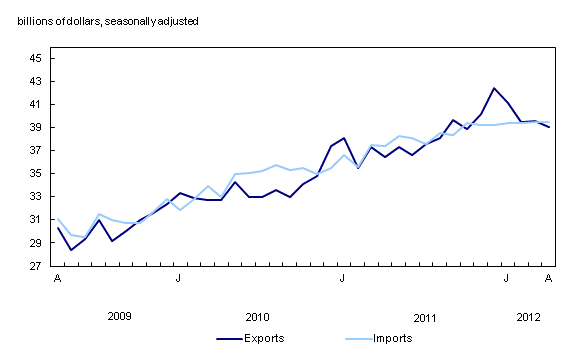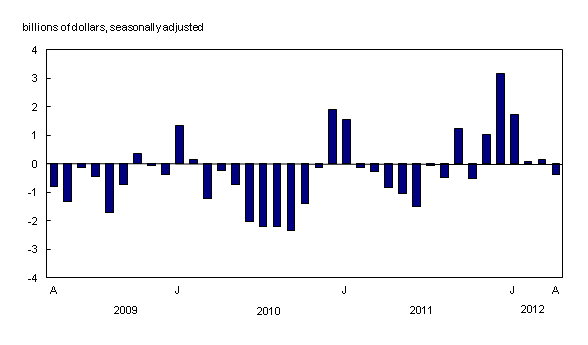Canadian international merchandise trade, April 2012
Archived Content
Information identified as archived is provided for reference, research or recordkeeping purposes. It is not subject to the Government of Canada Web Standards and has not been altered or updated since it was archived. Please "contact us" to request a format other than those available.
Related subjects
-
[an error occurred while processing this directive]
Canada's merchandise exports declined 1.2% in April, while imports edged up 0.1%. After five consecutive monthly surpluses, Canada posted a trade deficit of $367 million in April, down from a surplus of $152 million in March.
Exports and imports

Chart description: Exports and imports
Exports fell to $39.1 billion, the result of a 1.9% decline in prices. The main contributors to the overall decrease were exports of industrial goods and materials, as well as machinery and equipment.
Imports rose to $39.5 billion, their fifth consecutive monthly increase. The gains were led by higher imports of automotive products and other consumer goods, while imports of energy products declined.
Exports to the United States fell 1.2% to $28.4 billion in April, the fourth consecutive monthly decrease. Imports from the United States rose 1.3% to $24.6 billion. As a result, Canada's trade surplus with the United States decreased from $4.5 billion in March to $3.8 billion in April.
Exports to countries other than the United States decreased 1.2% to $10.7 billion in April, while imports declined 1.9% to $14.9 billion. Canada's trade deficit with countries other than the United States narrowed from $4.4 billion in March to $4.2 billion in April.
Exports: Widespread declines in industrial goods and materials sector
Exports of industrial goods and materials fell 5.8% to $9.3 billion in April, as widespread declines were recorded throughout the sector. Volumes fell 3.7%, while prices declined 2.1%. Metal ores as well as metals and alloys were the main contributors to the sector's decline, which was partially offset by gains in chemicals, plastics and fertilizers, particularly potash.
Exports of machinery and equipment decreased 3.1% to $6.7 billion, as volumes fell 3.4%. The main contributor to the decrease was a 14.1% decline in exports of aircraft, engines and parts.
Exports of energy products decreased 0.8% to $9.9 billion in April, as prices fell 6.7%. Crude petroleum exports dropped 9.0%, the third consecutive monthly decline that was a result of lower prices. Exports of petroleum and coal products increased 18.5%.
Automotive products exports rose 2.8% to $5.5 billion in April. Leading the gain were exports of passenger autos and chassis (+2.4%), followed by motor vehicle parts, which recorded its fifth consecutive monthly gain. These increases were on the strength of volumes.
Exports of agricultural and fishing products, which increased 3.8% to $3.7 billion, have been on an upward trend since March 2011. Volumes rose 2.7%. The main contributors to the sector's gain were higher exports of fish and fish preparations (+18.7%) and wheat (+12.1%).
Counterbalancing movements in imports
Imports of automotive products rose 2.6% to $6.8 billion in April, as volumes grew 3.2%. Imports of motor vehicle parts, up 5.4% to $2.9 billion, led the sector's gain.
Imports rose 2.6% to $5.1 billion in the other consumer goods sector, where widespread gains were recorded. The main contributor to the increase was imports of apparel and footwear (+11.1%), mostly the result of higher imports of apparel and apparel accessories.
Imports of industrial goods and materials rose 0.7% to $8.2 billion in April. Other industrial goods and materials (+2.5%) led the sector's increase on the strength of metal fabricated basic products.
Imports of energy products fell 6.8% to $4.1 billion, the result of lower prices and volumes. After three consecutive monthly increases, imports of crude petroleum fell 6.5% to $2.5 billion, as prices dropped 11.1%. Petroleum and coal products also contributed to the decline.
Imports of machinery and equipment decreased 0.6% to $10.8 billion in April. The decline was led by lower imports of office machines and equipment as well as other machinery and equipment, primarily laboratory equipment.
Trade balance

Chart description: Trade balance
Note to readers
Merchandise trade is one component of Canada's international balance of payments (BOP), which also includes trade in services, investment income, current transfers as well as capital and financial flows.
International merchandise trade data by country are available on both a BOP and a customs basis for the United States, Japan and the United Kingdom. Trade data for all other individual countries are available on a customs basis only. BOP data are derived from customs data by making adjustments for factors such as valuation, coverage, timing and residency. These adjustments are made to conform to the concepts and definitions of the Canadian System of National Accounts.
Data in this release are on a BOP basis, seasonally adjusted and in current dollars. Constant dollars are calculated using the Laspeyres volume formula.
New aggregation structure
Statistics Canada will introduce the North American Product Classification System (NAPCS) for merchandise import and export statistics. The new structure will replace the classification structures known as the summary import groups (SIG) and the summary export groups (SEG) and the higher level aggregations (major groups, subsectors, sectors and sections) that have been in use for several decades.
Revised data based on NAPCS for the reference period of January 1988 to August 2012 will be disseminated on October 18.
The first regular release of data based on NAPCS will be on November 8 for the September reference month.
Readers interested in this upcoming change can find more detailed information on our web page dedicated to classification consultation and notification.
Revisions
In general, merchandise trade data are revised on an ongoing basis for each month of the current year. Current year revisions are reflected in both the customs and BOP based data.
The previous year's customs data are revised with the release of the January and February reference months as well as on a quarterly basis. The previous two years of customs based data are revised annually and are released in February with the December reference month.
The previous year's BOP based data will be revised with the release of the January, February, March and April 2012 reference months.
Factors influencing revisions include late receipt of import and export documentation, incorrect information on customs forms, replacement of estimates produced for the energy sector with actual figures, changes in classification of merchandise based on more current information, and changes to seasonal adjustment factors.
Revised data are available in the appropriate CANSIM tables, free of charge.
Available without charge in CANSIM: tables CANSIM table228-0001 to 228-0003, CANSIM table228-0033, CANSIM table228-0034, CANSIM table228-0041 to 228-0043 and CANSIM table228-0047 to 228-0057.
The merchandise imports and exports data in the following tables are presented in dollar values.
Tables 228-0001 to 228-0003: Customs and balance of payments basis, by major groups and principal trading areas for all countries; monthly, quarterly and annual.
Table 228-0033: Imports, customs-based, by province of clearance; monthly.
Table 228-0034: Domestic exports, customs-based, by province of origin; monthly.
Tables 228-0041 to 228-0043: Customs and balance of payments basis, by sector and subsector, for all countries; monthly, quarterly and annual.
The merchandise imports and exports data in the following tables are indexes (2002=100).
Tables 228-0047 to 228-0049: Balance of payments and customs-based price and volume indexes for all countries; monthly, quarterly and annual.
Tables 228-0050 to 228-0052: Customs-based price indexes, Canada and United States trade, and Standard International Trade Classification (SITC revision 3) price indexes for all countries and United States; monthly, quarterly and annual.
Tables 228-0053 to 228-0055: Price and volume indexes customs and balance of payments basis, by sector and subsector, for all countries; monthly, quarterly and annual.
Tables 228-0056 and 228-0057: Balance of payments basis, by sector, seasonally adjusted, Fisher formula, chained 2002 dollars, for all countries; monthly and quarterly.
Definitions, data sources and methods: survey numbers survey number2201, survey number2202 and survey number2203.
These data are available in the Canadian international merchandise trade database.
The April 2012 issue of Canadian International Merchandise Trade, Vol. 66, no. 4 (Catalogue number65-001-X, free), is now available from the Key resource module of our website under Publications.
Current account data (which incorporate merchandise trade statistics, service transactions, investment income and transfers) are available quarterly in Canada's Balance of International Payments (Catalogue number67-001-X, free).
Data on Canadian international merchandise trade for May will be released on July 11.
For more information, contact Statistics Canada's National Contact Centre (toll-free 1-800-263-1136; 613-951-8116; infostats@statcan.gc.ca).
To enquire about the concepts, methods or data quality of this release, contact Marc Nadeau (613-951-3692), International Trade Division.
- Date modified:
